Dancing in Arrate: Virgins, Punks, Basques and…Morris?
The next few days were spent walking around Eibar, seeing the town, catching up on my blog, and learning about Basque dancing! First of all: There is a lot of it! Huge numbers of teams to sword dancing, mostly in early summer, and mostly non-Hilt-and-Point dancing, but still a good number of those too!
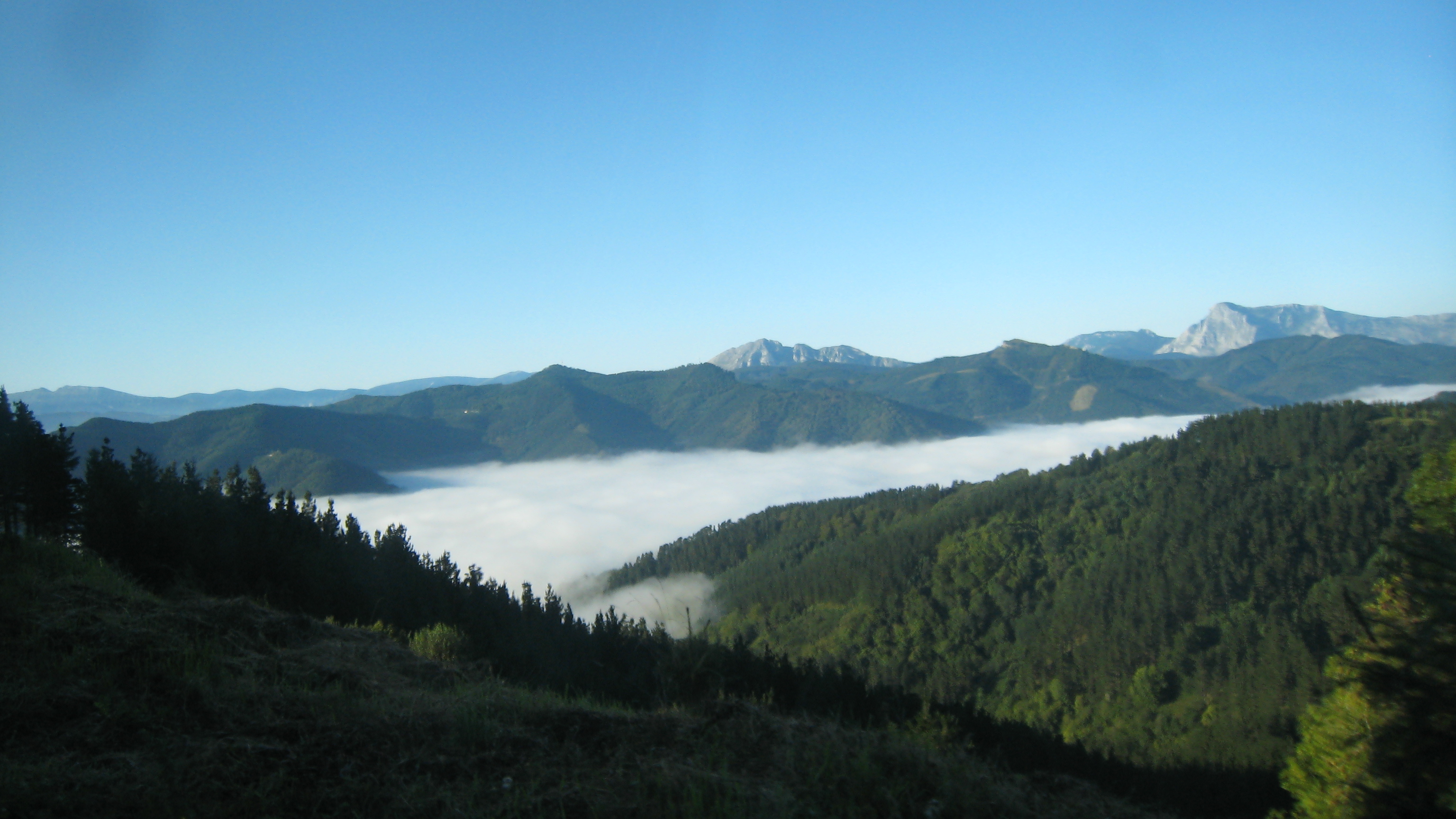 I woke up at eight on the morning of the 8th of September, ready for a big day of dancing. This was the dance that had initially drew me to Basque country I was ready to take it all in. I gathered up my essentials, which basically just added the video camera and laptop to my regular day’s supplies. I almost always carry around: wallet, phone, camera, notebook, and pen. Inevitably when I don’t bring them, I regret it. Oier had shown me the day before where the buses were leaving from. The events take place at in Arrate, where the Virgin is, and in former days people used to get up at five or six to walk up the mountain to get there. I was happy not to have to walk (although some people still did) and so determined to see everything that I wanted to get on the first round of buses. Actually, it was the first bus in the first set. In the seat next to the driver. I told you I wanted to see it all. We drove up the mountain road, the driver honking the horn loudly every time we neared a curve. I wouldn’t have guessed that the roads could have fit a bus at all, so the idea of passing was rather terrifying. As long as I wasn’t contemplating hurtling off the edge, the mountains were beautiful. The valley where the town lay was covered in clouds, and pretty soon we were above them. For this particular event, Kezka, the group Oier runs, has started inviting master dancers to perform as the soloists (you’ll see!) in the dance. This then enters them into a society of sorts where they have the right to come back and dance from then on out. This seems to be a good way to both get really good dancers involved and build inter-town (group) community! When Kezka started doing a larger version of their dance (not just soloists) in recent years, they also decided to include women in the dancing, which at the time was rare for Basque Sword dancing (Heck, english sword dancing). Now there are several other teams that have followed suit. Anyway, I’m getting ahead of myself (though still behind, I writing this from a park bench in Marin, a port town in Galicia, Spain. ) I hop out of the bus, the absolute first person up that day.
I woke up at eight on the morning of the 8th of September, ready for a big day of dancing. This was the dance that had initially drew me to Basque country I was ready to take it all in. I gathered up my essentials, which basically just added the video camera and laptop to my regular day’s supplies. I almost always carry around: wallet, phone, camera, notebook, and pen. Inevitably when I don’t bring them, I regret it. Oier had shown me the day before where the buses were leaving from. The events take place at in Arrate, where the Virgin is, and in former days people used to get up at five or six to walk up the mountain to get there. I was happy not to have to walk (although some people still did) and so determined to see everything that I wanted to get on the first round of buses. Actually, it was the first bus in the first set. In the seat next to the driver. I told you I wanted to see it all. We drove up the mountain road, the driver honking the horn loudly every time we neared a curve. I wouldn’t have guessed that the roads could have fit a bus at all, so the idea of passing was rather terrifying. As long as I wasn’t contemplating hurtling off the edge, the mountains were beautiful. The valley where the town lay was covered in clouds, and pretty soon we were above them. For this particular event, Kezka, the group Oier runs, has started inviting master dancers to perform as the soloists (you’ll see!) in the dance. This then enters them into a society of sorts where they have the right to come back and dance from then on out. This seems to be a good way to both get really good dancers involved and build inter-town (group) community! When Kezka started doing a larger version of their dance (not just soloists) in recent years, they also decided to include women in the dancing, which at the time was rare for Basque Sword dancing (Heck, english sword dancing). Now there are several other teams that have followed suit. Anyway, I’m getting ahead of myself (though still behind, I writing this from a park bench in Marin, a port town in Galicia, Spain. ) I hop out of the bus, the absolute first person up that day.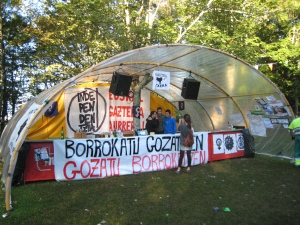 That isn’t to say that there are not other people there, far from it. I walk towards the church and find myself passing through what looks like the remenentts of a anarcho-punk show. Lots of 20-somethings with pierced eyebrows, mullets, black bandanas and chains stand around or wearily dance to the last bits of music. Signs calling for Basque independence or freedom for political prisioners are in the trees, on the tents, and sewn onto shirts. I ask one of my bus mates if this is part of the festival, wondering if it is indeed some unrelated event. Nope, it was the beginning of the festival, they have stayed up all night and now some of them will sleep while others will go to mass. Rather different meanings attached to similar symbols! I get a call from Oier asking where I am, and after a brief confusion we confirm that we are both in Arrate. He comes and meets me to give me a little tour where the dancing and procession will happen to give me a chance to scout out filming locations and get some more info on the festival.
That isn’t to say that there are not other people there, far from it. I walk towards the church and find myself passing through what looks like the remenentts of a anarcho-punk show. Lots of 20-somethings with pierced eyebrows, mullets, black bandanas and chains stand around or wearily dance to the last bits of music. Signs calling for Basque independence or freedom for political prisioners are in the trees, on the tents, and sewn onto shirts. I ask one of my bus mates if this is part of the festival, wondering if it is indeed some unrelated event. Nope, it was the beginning of the festival, they have stayed up all night and now some of them will sleep while others will go to mass. Rather different meanings attached to similar symbols! I get a call from Oier asking where I am, and after a brief confusion we confirm that we are both in Arrate. He comes and meets me to give me a little tour where the dancing and procession will happen to give me a chance to scout out filming locations and get some more info on the festival. 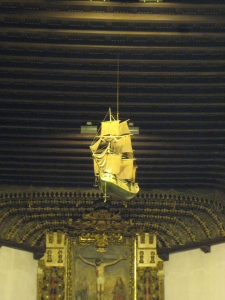 But first he shows me the church, in which hangs a boat. The church can be seen (on a clear day) from the sea, in between two mountains. Sailors used to use it as a landmark for their ship, and in this area of Basque country, it isn’t the stork that brings children, but the ship in the church of Arrate. The procession goes from outside the church up to the top of the hill where there is a cross facing the town of Eibar. there is a pause and some dancing and some talking and blessing and singing and then they go back to the field with the music and do more dancing. The cross on the hill has a good story with it; apparently if you want a girlfriend (or, assumedly, a boyfriend) you have to walk twice around each level of circular steps at the base of the cross, “and then you will get one!” We went back to a little building to the side of everything where I found the rest of the group already getting prepared. They were all pulling on stockings, tying bandanas and gathering swords. While they dressed, several members started singing traditional Basque songs. These turned out to be super beautiful, and I now have a dinner date to learn several of them and try to record different parts.[youtube=http://www.youtube.com/watch?v=N7nfyzkFXAw] After everyone is in kit, the whole team files out onto the balcony to take the group photo.
But first he shows me the church, in which hangs a boat. The church can be seen (on a clear day) from the sea, in between two mountains. Sailors used to use it as a landmark for their ship, and in this area of Basque country, it isn’t the stork that brings children, but the ship in the church of Arrate. The procession goes from outside the church up to the top of the hill where there is a cross facing the town of Eibar. there is a pause and some dancing and some talking and blessing and singing and then they go back to the field with the music and do more dancing. The cross on the hill has a good story with it; apparently if you want a girlfriend (or, assumedly, a boyfriend) you have to walk twice around each level of circular steps at the base of the cross, “and then you will get one!” We went back to a little building to the side of everything where I found the rest of the group already getting prepared. They were all pulling on stockings, tying bandanas and gathering swords. While they dressed, several members started singing traditional Basque songs. These turned out to be super beautiful, and I now have a dinner date to learn several of them and try to record different parts.[youtube=http://www.youtube.com/watch?v=N7nfyzkFXAw] After everyone is in kit, the whole team files out onto the balcony to take the group photo.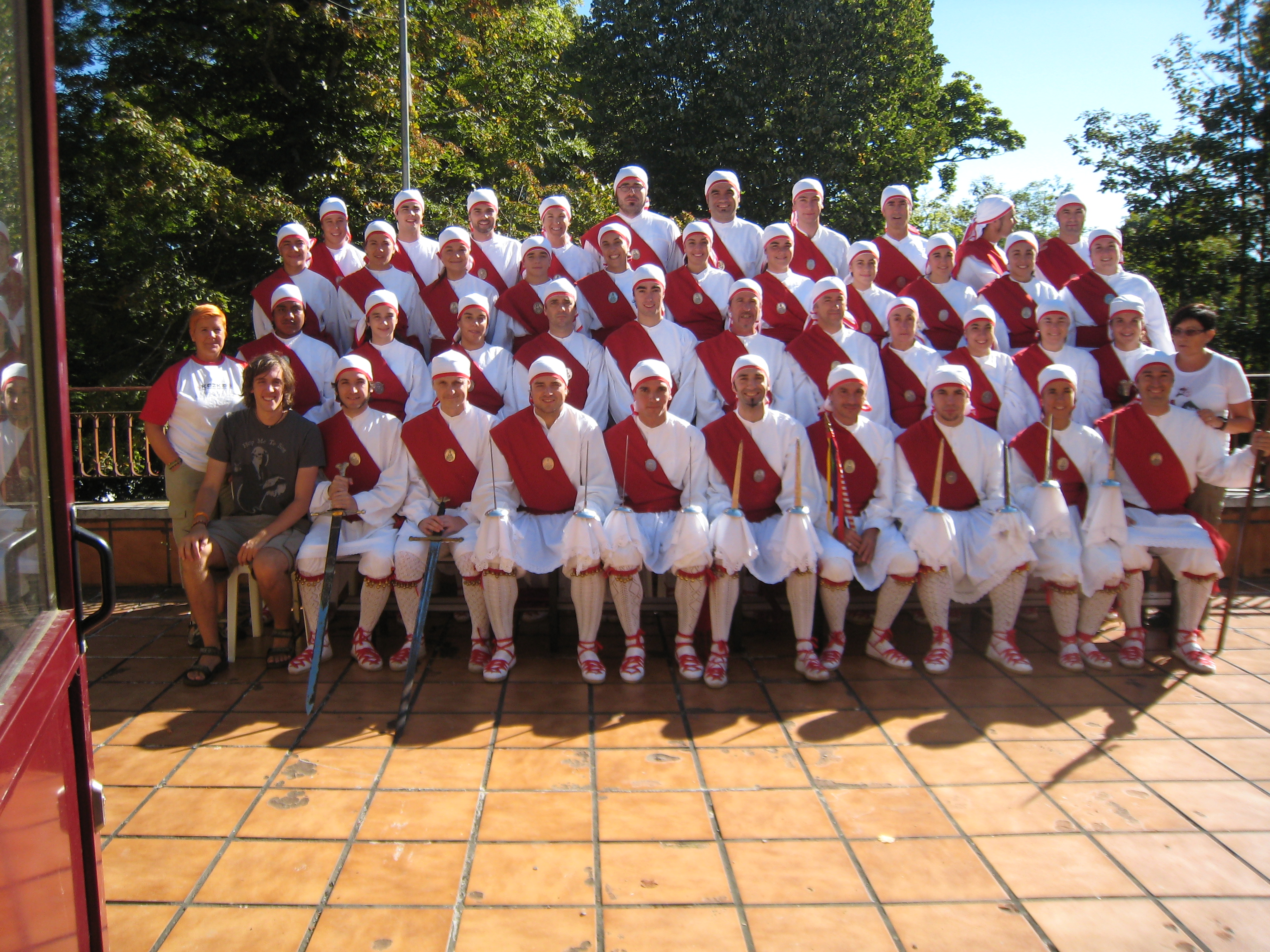
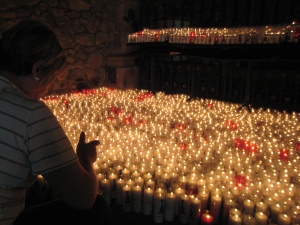 We walk to the church and just see the last bit of the mass taking place. By now, the candles that people have been leaving on stands have overflowed onto the floor and take up a good half of the room. There is a press of people in the back, but I wiggle my way through to make it to the front of the hall before the dancers get there. The priest calls for the dancers, and they enter, with the Txistu players (the Txistu, pronounced Chi-stew, is the traditional basque pipe, played like pipe and tabor.) and proceed with swords held in four long lines down the hall, with a single leader in the center. The leader (kapitain) changed his hands and reversed directions, making a bridge back over the lines. Two soloists came to the front from out of the tunnels and once the lines had doubled back another time they paused.
We walk to the church and just see the last bit of the mass taking place. By now, the candles that people have been leaving on stands have overflowed onto the floor and take up a good half of the room. There is a press of people in the back, but I wiggle my way through to make it to the front of the hall before the dancers get there. The priest calls for the dancers, and they enter, with the Txistu players (the Txistu, pronounced Chi-stew, is the traditional basque pipe, played like pipe and tabor.) and proceed with swords held in four long lines down the hall, with a single leader in the center. The leader (kapitain) changed his hands and reversed directions, making a bridge back over the lines. Two soloists came to the front from out of the tunnels and once the lines had doubled back another time they paused.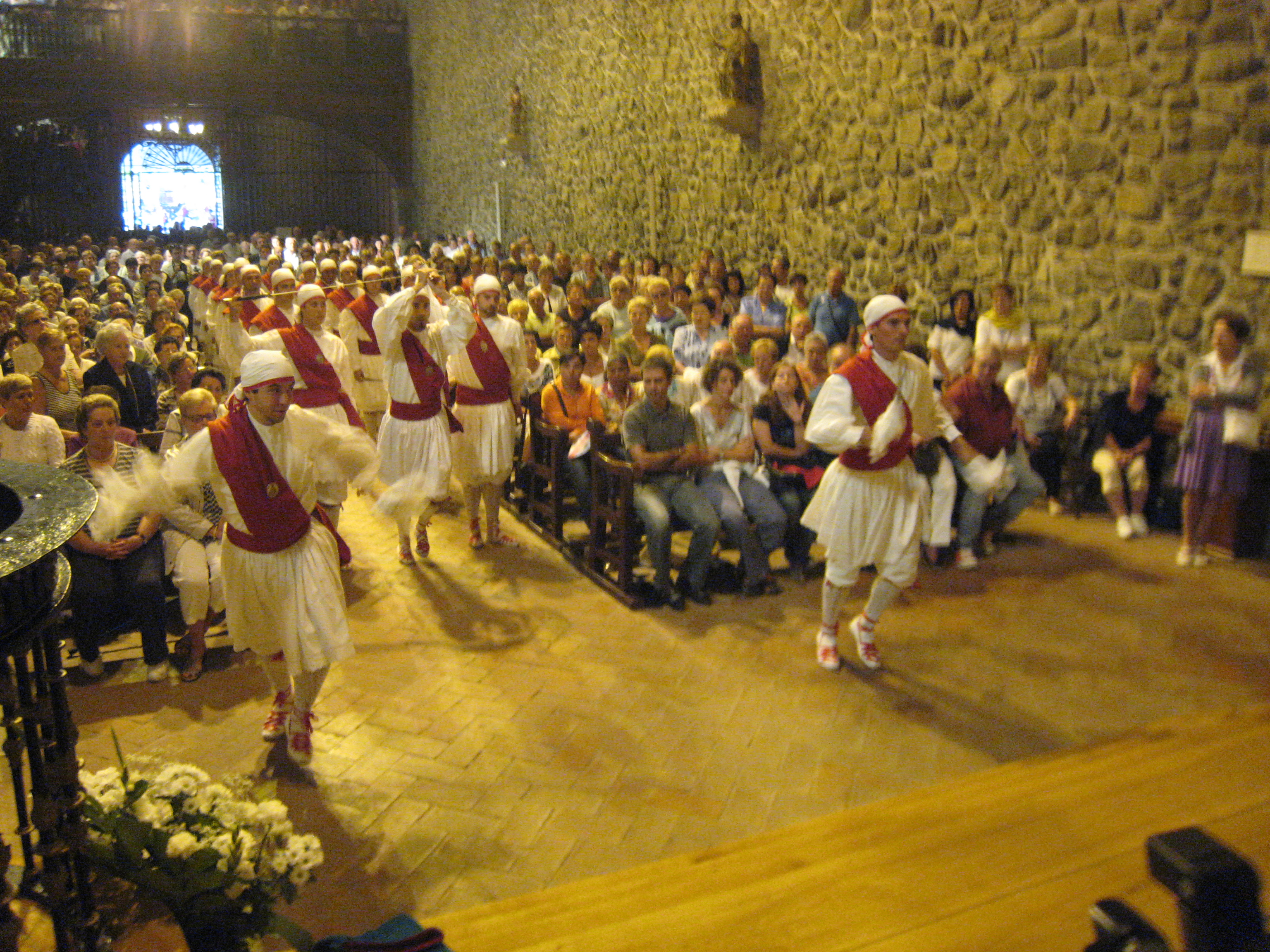
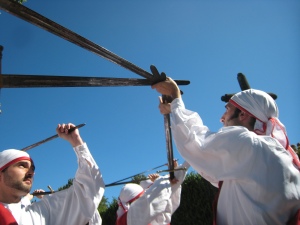 The dancers paused in place with swords upraised as the soloists danced a series of complicated steps, along with the lead dancer of the group. The dance was elaborate, with high kicks and jumps, danced with a small dagger held upright in each hand with a white handkerchief fringe around it. These were used to sketch movement in the air, in a similar fashion to how a handkerchief in Morris might be used. When this dance was completed, the rest of the team bridged back around on itself and the soloists followed them out of the church again. There was a brief pause and then the Vigin was carried out by a number of men. The sword dancers (Ezpata Dantza) formed up in front of them, lead by two men (Buruzagia) carrying objects that are symbols of power (see last post) called Buruzagi-makila and Lantza and followed by the soloists. With the sound of Txistu we set out up the hill, past the stands selling pastries and other treats, up to the hilltop cross. After some singing and speeches, the dancers danced once again and we headed back to the main field. There, the full dance was performed on the field. The first part was the same as before with the doubling back and the soloists’ dance. They group then went on into a different section which had striking similarities to the dances I had seen in Italy. They started differently, standing in a grid of the four lines with swords dropped, while the leader came around to the right hand side of the front line, and took the sword of the first dancer. he proceeded to run, the dancers linking swords as he passed each line, until the group was just one long line. They wound some figures, but eventually formed a star in the same manner as the italians. the leader stopped and held up his sword, the second man stopped opposite to him, the third man ran around the pair until he was next to the first, the two swords crossed in the middle. This continued until the whole group had been wound into a circle. A man then climbed on top of the star and was raised up into the air, short daggers in hand. The soloists danced their dance, while the man in the air performed the same hand movements (but did not jump, for reasons which I hope are obvious!)
The dancers paused in place with swords upraised as the soloists danced a series of complicated steps, along with the lead dancer of the group. The dance was elaborate, with high kicks and jumps, danced with a small dagger held upright in each hand with a white handkerchief fringe around it. These were used to sketch movement in the air, in a similar fashion to how a handkerchief in Morris might be used. When this dance was completed, the rest of the team bridged back around on itself and the soloists followed them out of the church again. There was a brief pause and then the Vigin was carried out by a number of men. The sword dancers (Ezpata Dantza) formed up in front of them, lead by two men (Buruzagia) carrying objects that are symbols of power (see last post) called Buruzagi-makila and Lantza and followed by the soloists. With the sound of Txistu we set out up the hill, past the stands selling pastries and other treats, up to the hilltop cross. After some singing and speeches, the dancers danced once again and we headed back to the main field. There, the full dance was performed on the field. The first part was the same as before with the doubling back and the soloists’ dance. They group then went on into a different section which had striking similarities to the dances I had seen in Italy. They started differently, standing in a grid of the four lines with swords dropped, while the leader came around to the right hand side of the front line, and took the sword of the first dancer. he proceeded to run, the dancers linking swords as he passed each line, until the group was just one long line. They wound some figures, but eventually formed a star in the same manner as the italians. the leader stopped and held up his sword, the second man stopped opposite to him, the third man ran around the pair until he was next to the first, the two swords crossed in the middle. This continued until the whole group had been wound into a circle. A man then climbed on top of the star and was raised up into the air, short daggers in hand. The soloists danced their dance, while the man in the air performed the same hand movements (but did not jump, for reasons which I hope are obvious!)
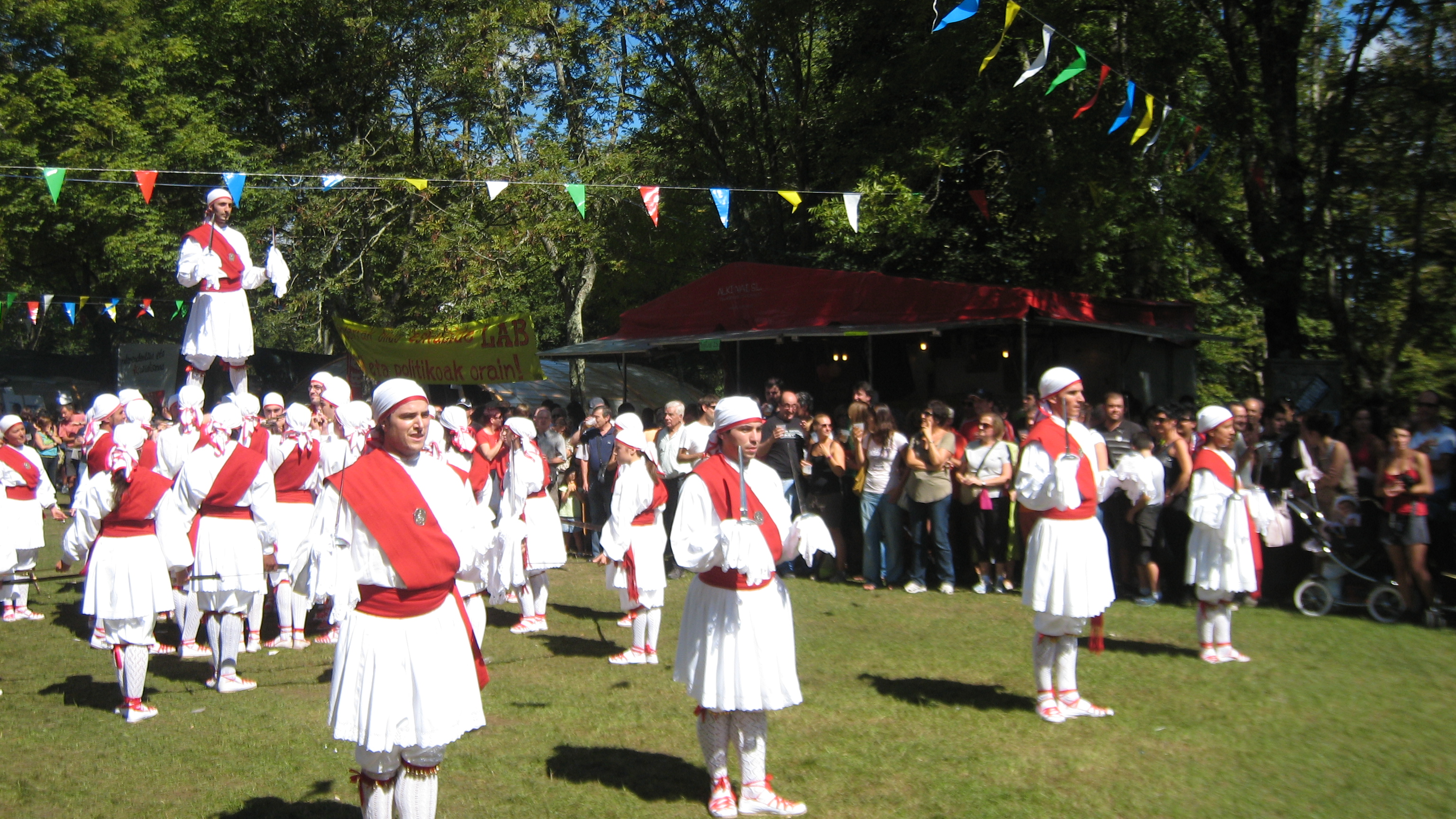
They lowered him down and the dancers unwound again winding out into a circle. The captain led them down to the far end of the field, and then the music changed (in the exact shift of the Bagnasco dance for the same figure!!) and the dancers started running to form a “bridge”, with one dancers turning alternate directions to form a crossing archway of swords. This figure is written about in Basque as far back as 1824 in Guipuzcoa’ko Dantza Gogoangarriak (Old Dances of Gipuuzcoa) by Juan Ignacio de Iztueta and will appear in several other dances throughout Basque country and Spain. 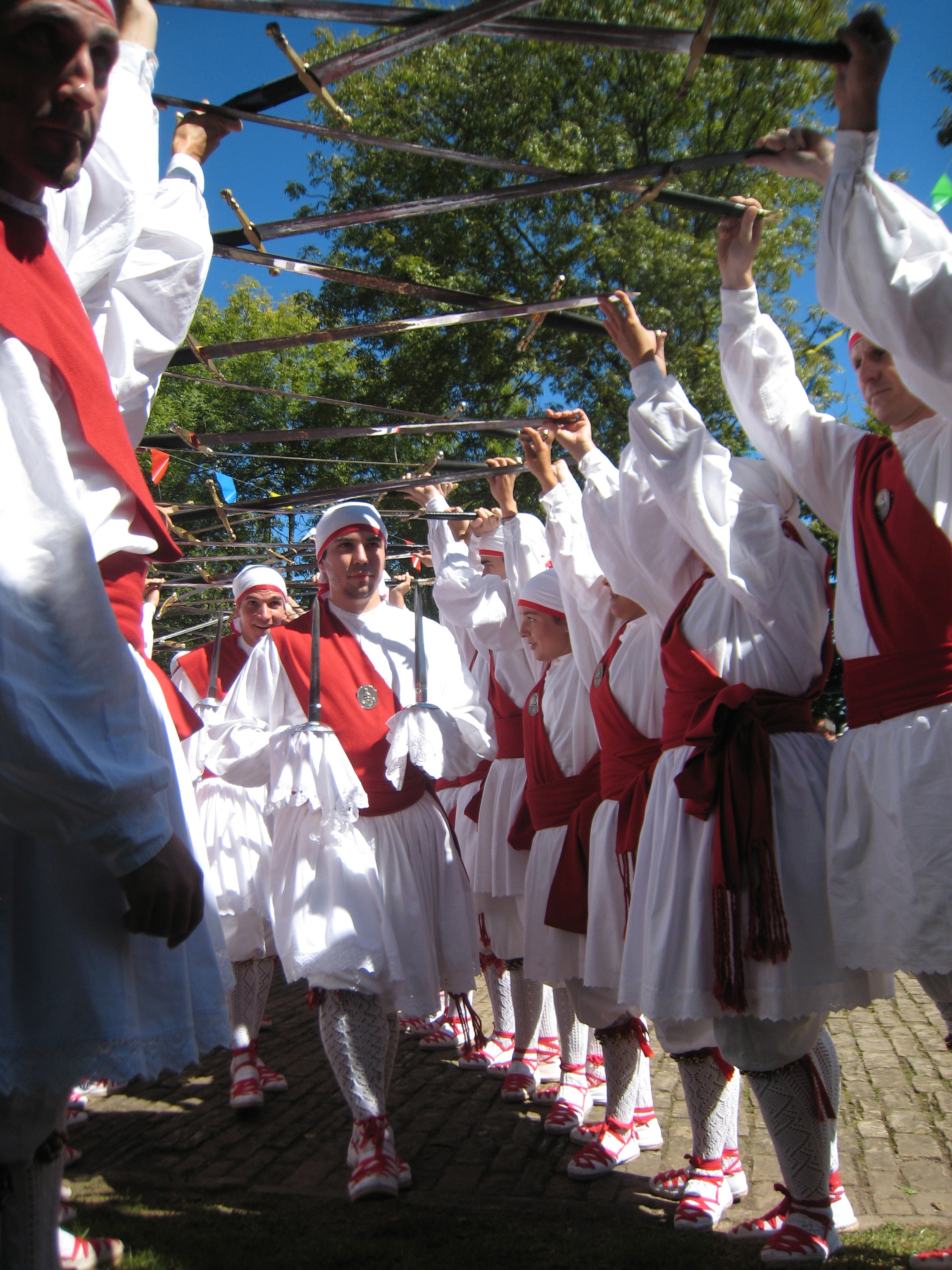
Through this arch the soloists then process before the whole thing is unwound, and dancers form back into the original formation and process out. There was a pause for a while before the next round of dances started up. I had seen some pictures of Basque stick dances, but I still wasn’t prepared for the amazing similarities between this dancing and Morris. The music, the movements, the costumes, the bells on their feet, all of it was eerily similar. 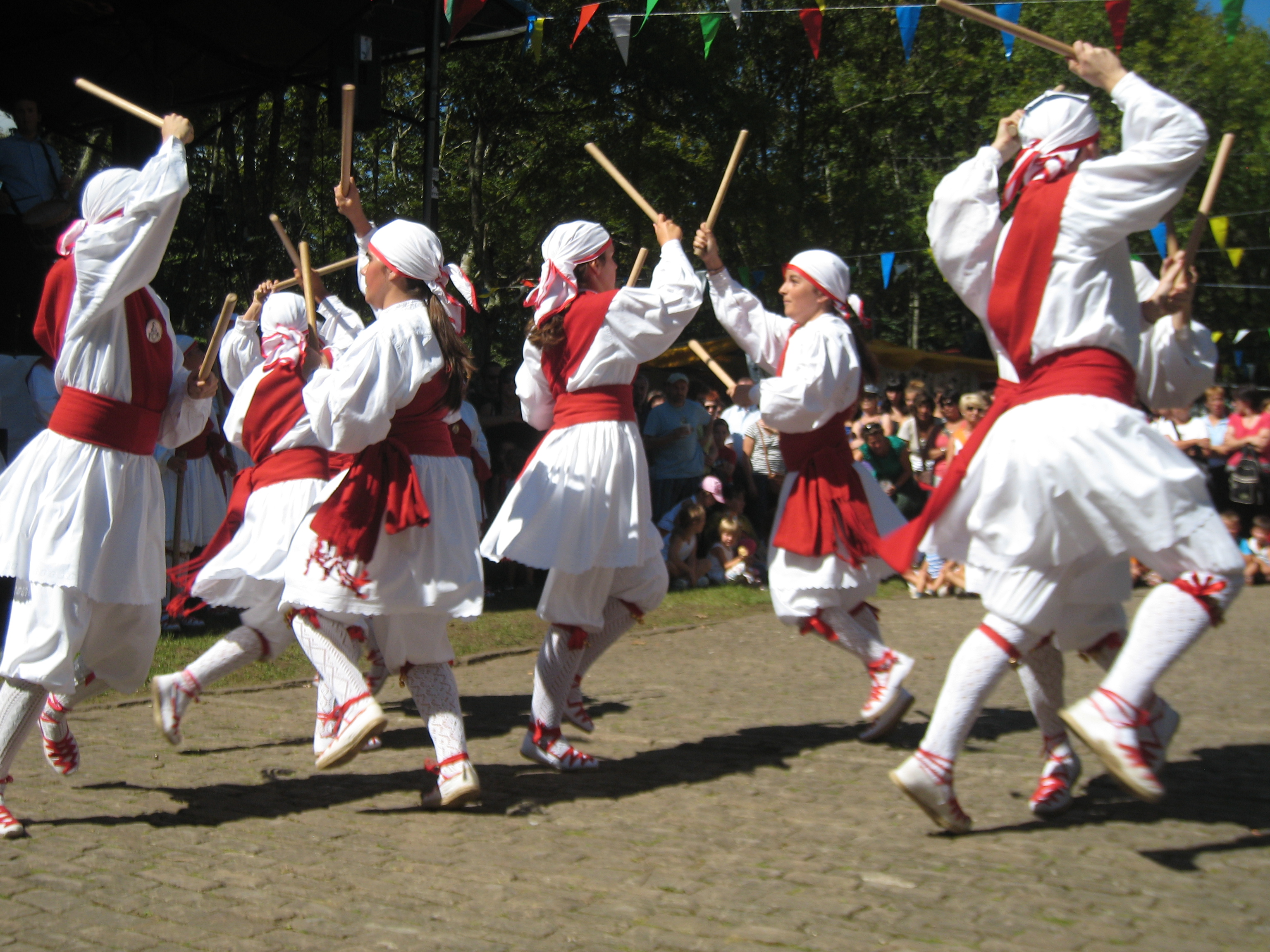
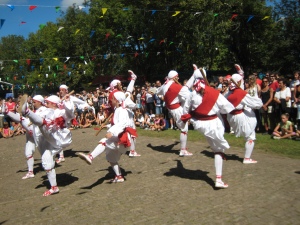
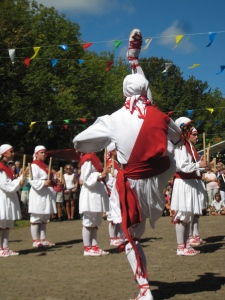 Well, except for the fact that they have been training since they were six or seven years old and can kick way above their heads and do entrechats in the middle of things! Yeah, it’s like super baddass morris! It was one of those amazing suprises that this trip keeps throwing at me. Not what I was looking for exactly, but so much cooler than anything I could have though up to actually seek out for myself! They dance different dances with objects, called (trokeo-dantza). There is one with little sticks (makila txikiena), big sticks (makila handiena), and shields (brokel-dantza). Each dance starts with the buruzagi dancing a solo dance, before the group (in sets of eight) performs the full dance (Taldearen zortzikoa).
Well, except for the fact that they have been training since they were six or seven years old and can kick way above their heads and do entrechats in the middle of things! Yeah, it’s like super baddass morris! It was one of those amazing suprises that this trip keeps throwing at me. Not what I was looking for exactly, but so much cooler than anything I could have though up to actually seek out for myself! They dance different dances with objects, called (trokeo-dantza). There is one with little sticks (makila txikiena), big sticks (makila handiena), and shields (brokel-dantza). Each dance starts with the buruzagi dancing a solo dance, before the group (in sets of eight) performs the full dance (Taldearen zortzikoa).
After the formal dancing was done music started on the stage and the mingling and informal dancing began. I was filming two old women dancing, and when they spotted me they pulled me over to join in. Oier came too and we all ended up dancing Tarantella together.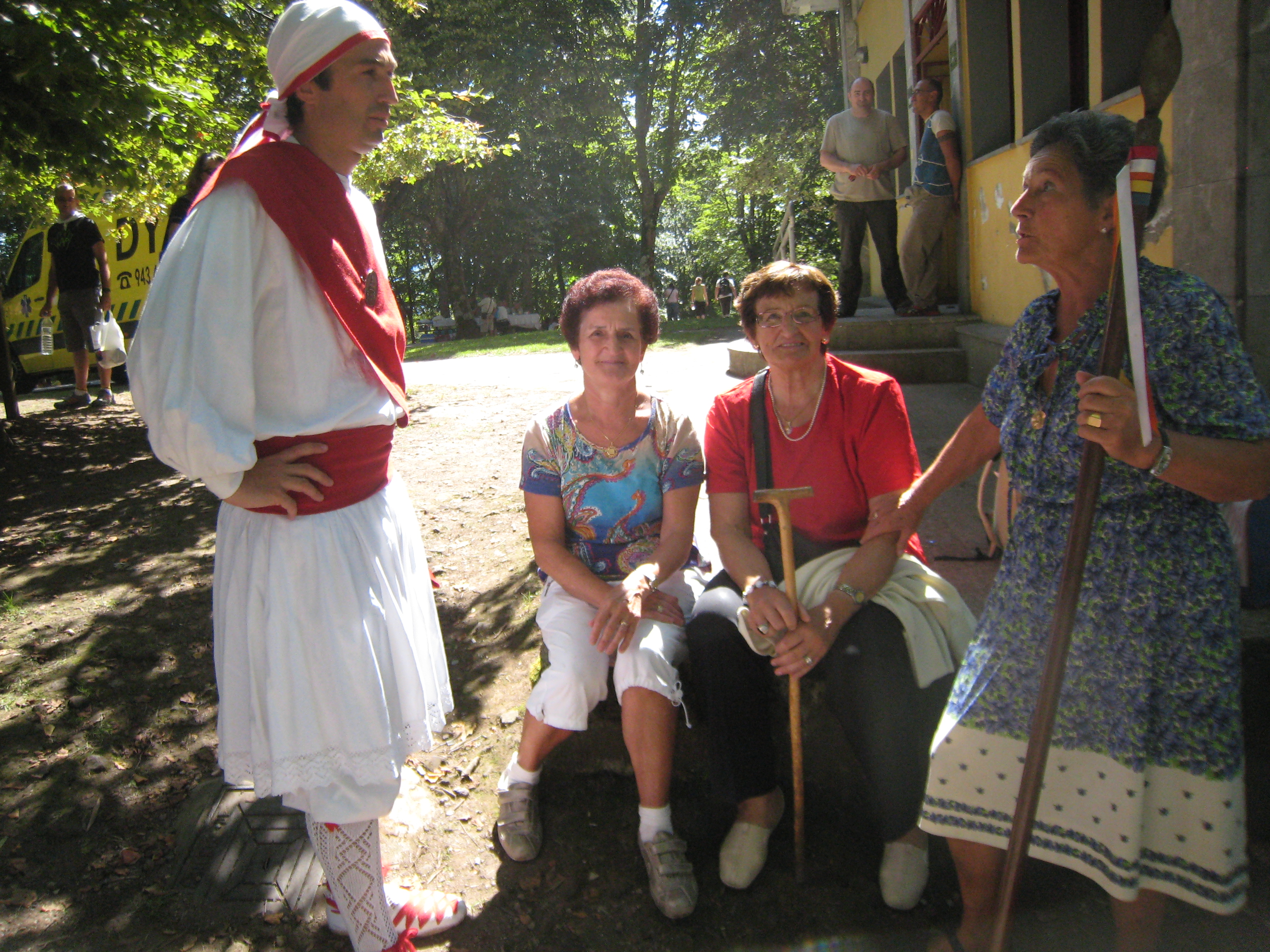
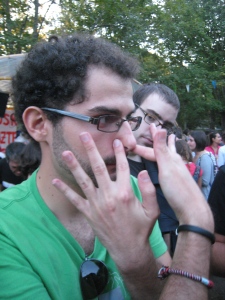 A little later on the team had a meal together in the nearby restaurant. I was herded over to the “English Practice Table” with a number of the younger dancers who spoke varying degrees of English. We had a small feast, with various toasts and the secretary reading the day’s account that he had written in a large book. Everyone wanted to know what I thought about basque dancing, Basque food, and the Basque country in general. I assured one and all that it was awesome, and I loved it. This is true. The people I have met here are amazingly friendly, generous, and excited about sharing their culture, dances, and food! After the meal was done all the dancers signed their names in the book (Sort of a cool tradition really!) and we headed back out to dance some more. Somehow we got onto the topic of strange games and tricks, and I won a fair deal of acceptance with the nose trick as well as a few others. It was also time for a group photo, so the team, now out of costume, gathered together for a moment in celebration!
A little later on the team had a meal together in the nearby restaurant. I was herded over to the “English Practice Table” with a number of the younger dancers who spoke varying degrees of English. We had a small feast, with various toasts and the secretary reading the day’s account that he had written in a large book. Everyone wanted to know what I thought about basque dancing, Basque food, and the Basque country in general. I assured one and all that it was awesome, and I loved it. This is true. The people I have met here are amazingly friendly, generous, and excited about sharing their culture, dances, and food! After the meal was done all the dancers signed their names in the book (Sort of a cool tradition really!) and we headed back out to dance some more. Somehow we got onto the topic of strange games and tricks, and I won a fair deal of acceptance with the nose trick as well as a few others. It was also time for a group photo, so the team, now out of costume, gathered together for a moment in celebration!
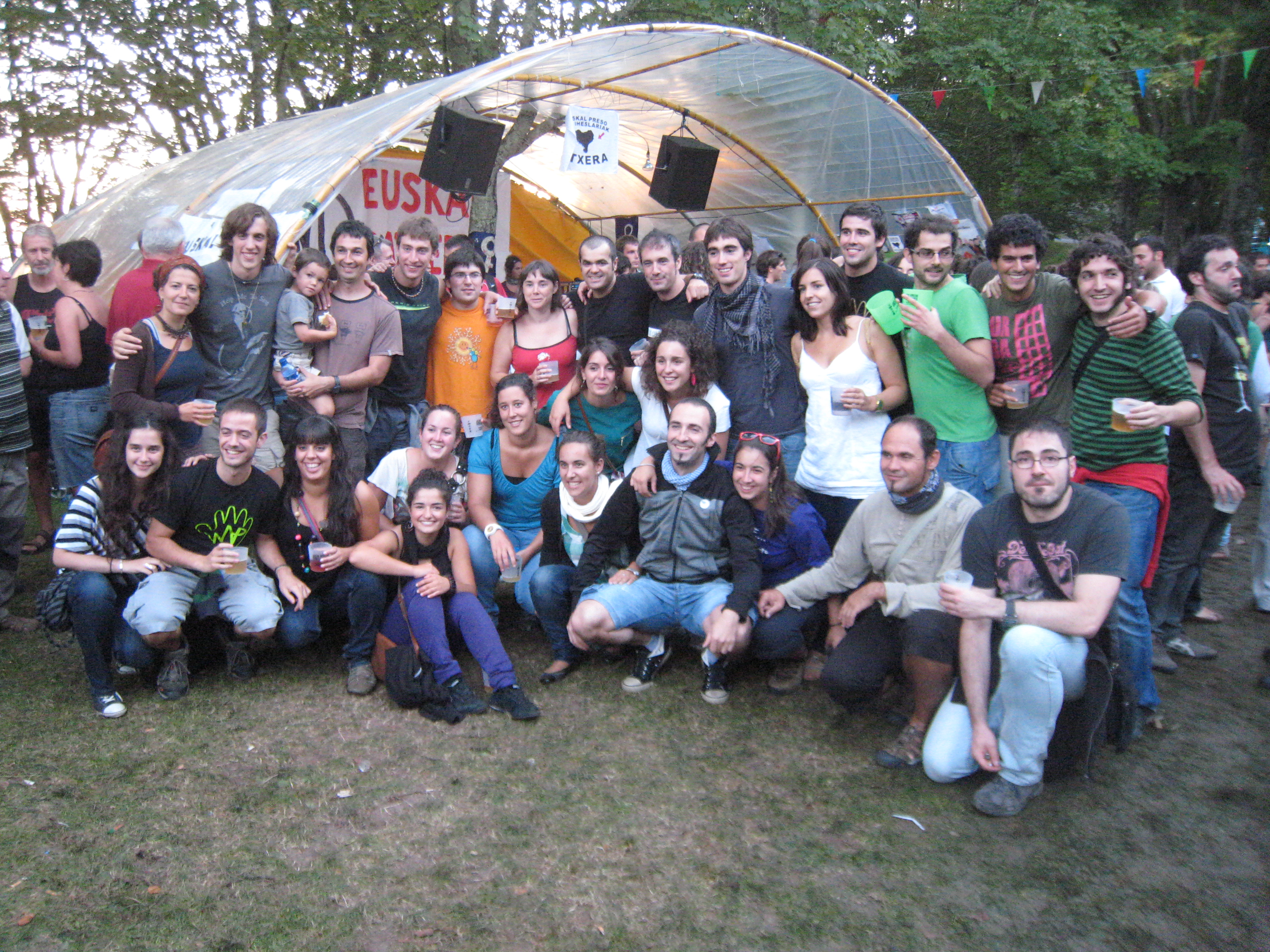
The first band to play was called “Joselu Anaiak) and was comprised of Jose Luis and his four brothers. I was really delighted to see a bunch of the 30 year olds with piercings and a cigarette in one hand and beer in the other dancing the same dances as the nine year old girls. [youtube=http://www.youtube.com/watch?v=yJf6ddeOdus]
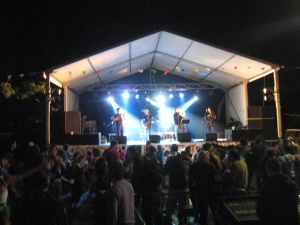
We all danced together and later in the night several members of Kezka played in their band MP5. Their “smash hit” was a song to the tune of The Final Countdown that they had changed the words to to be about how you need to lock your bicycle (all in basque of course). The clever thing was that that refrain sounded rather similar to “It’s the final countdown!” With lead accordion. Oy 
Finally, I was exhausted and caught the second to last bus home. The drive at night was even more terrifying, but luckily I was far to tired to care, and dozed off for most of it. I got off a stop early, so I had a nice long walk back to the dorm, but man, what a day!
Fabulous photos of the dancing! You have a good eye for the moment.
I love it! Missing Arrate! But I enjoied reading you.
I miss you guys too! I just posted my last basque post and I’m sad about leaving!
Jeremy! we uploaded Two video you gave us, to the Groups’ youtube account!
how are you Now? where are you exactly? hope you can visit us again!
videos:
http://youtu.be/qI__JLNcgcI
http://www.youtube.com/watch?v=OvD35gXJSMg
Hugs from Eibar!
Hi there! I’m glad that you like the videos! Miss you guys!
[…] up to the dancing. That’s pretty much what happened. On the train I phoned Oier (the sword dancer in Basque country, remember?) who kindly agreed to use his credit card to buy me a ticket and I would pay him back, […]
[…] and carrying two short wooden sticks. This was a similar outfit to the one the dancers at the Arrate sword dance wore, but with the addition of the shawls, flowers and masks (it is carnival after all!) In the […]
[…] Basque Country came the group Andra Mari, led by a man that I had actually met in Arrate in September! He recognized me when I came backstage and introduced me to the leaders of the German team, for […]